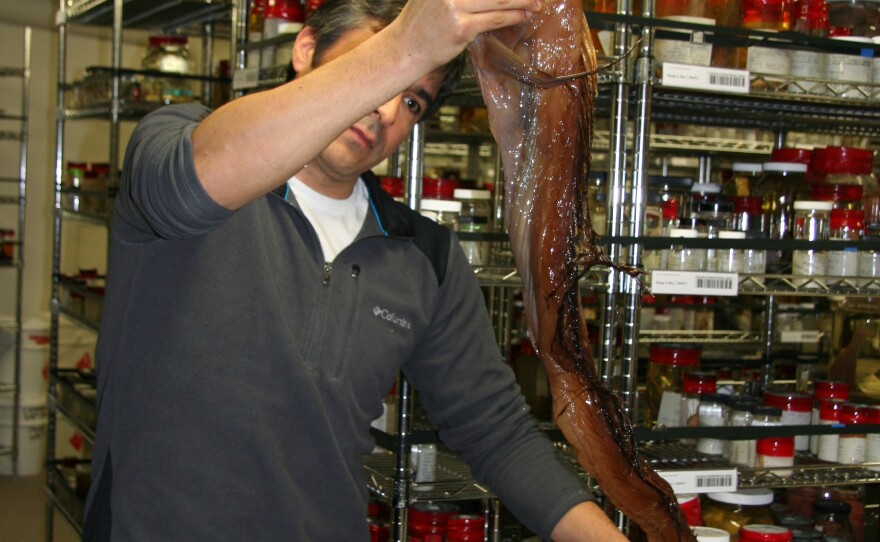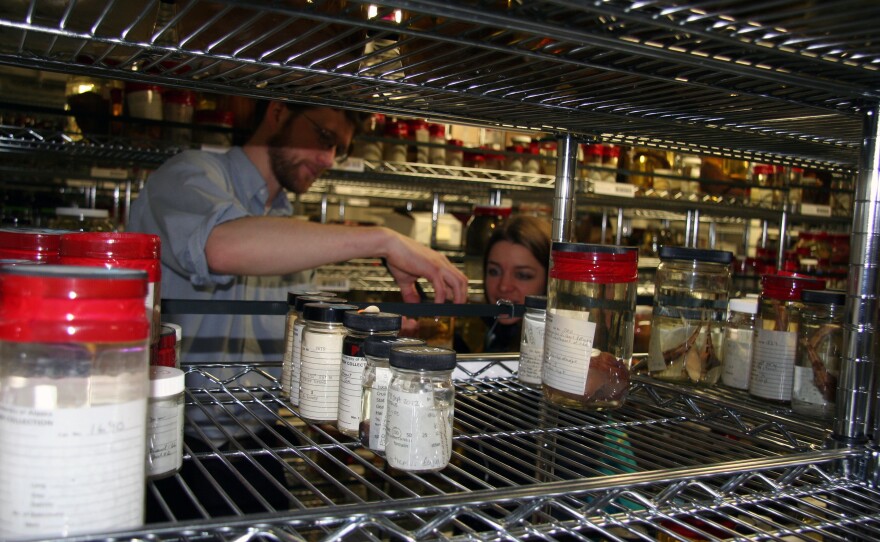Fairbanks, AK - The University of Alaska, Fairbanks Museum of the North recently acquired as many as 150-thousand fish and marine invertebrate specimens from the National Marine Fisheries Service. The acquisition means the museum’s fish collection has doubled in size.
Beneath the permanent and special exhibits, the Fred Machetanz paintings, Otto the Bear and a giant Wooly mammoth skull, there’s a maze of rooms in the basement of the Museum of the North filled with… well, dead things. But these aren’t just typical dead things. They’re extremely useful to scientists like Andres Lopez, he's the Curator of the fish collection at the museum. Inside a room full of metal shelves, the sit hundreds of glass jars, filled with yellow-tinted ethanol. Dead fish are submerged in each jar. There are big and small fish, long fish, short fish, fat fish, skinny fish. Their age and the ethanol has turned some of them into reddish-grayish-blue fish. “All jars have labels in them," explains Lopez. "Those labels contain all the information we have regarding the identity of the animal in there, the species they belong to, but most importantly when they were collected, where they were collected, who collected them. That’s the essential information that we keep here in research collections,” he says.
This collection has always been relatively small in comparison to those at other museums, but it recently doubled in size. The National Marine Fisheries Service transferred thousands of specimens to the museum from a lab in Auke Bay, near Juneau this fall.
Lopez says the transfer is a big deal for future research. “The more specimens you have representing the region you’re interested in, the more value a researcher that comes to visit or that loans material from us will get from those collections because they can get samples from more locations, more occurrences of that species are represented in our database,” he says.
The transfer adds tens-of-thousands of fish to the collection. All of them were caught in Alaskan waters. The added specimens mean there’s more information about evolution, life history and habitat. But not all the specimens are stored in jars. Some are just too big. Lopez reaches into a round, plastic tub. He pulls out a long, menacing Lancet fish. It has razor sharp teeth as large as fingers - good for hunting smaller fish in the Bering Sea. Fish even larger than this are stored in stainless steel tanks the size of shopping carts.
Collections Technician Robert Marcotte snaps open a tank. As soon as he lifts the lid, the smell of isopropanol – a kind of alcohol – hits us. “So, that’s mixed with like a dead fish ocean type smell and each specimen has been fixed in formalin or formaldehyde, so in theory it’s not rotting," says Marcotte, "but they’re still giving off a little bit of juice," he says. “The oils and things like that seep out of the fish over time, so that’s what you’re smelling.”
Marcotte rolls up his sleeves, reaches in and grabs a fat, dark brown creature. In another tank, he finds a big round fish. It looks like a dramatically oversized silver dollar with spots. This tropical fish likely got lost in the Gulf of Alaska. “If a fish gets lost due to an El Nino event or due to strange currents, or just winds its way up in Alaska and gets caught and it’s recognizably not a local fish, it will end up here because it’s so unique,” he says.
There are about 500 fish species native to Alaska. The vast majority live in the ocean. Only about 60 show up occasionally in fresh water across the state. Two other large research collections in the country include fish from the Far North, but this is the largest collection of specifically Alaskan fish in the world.






